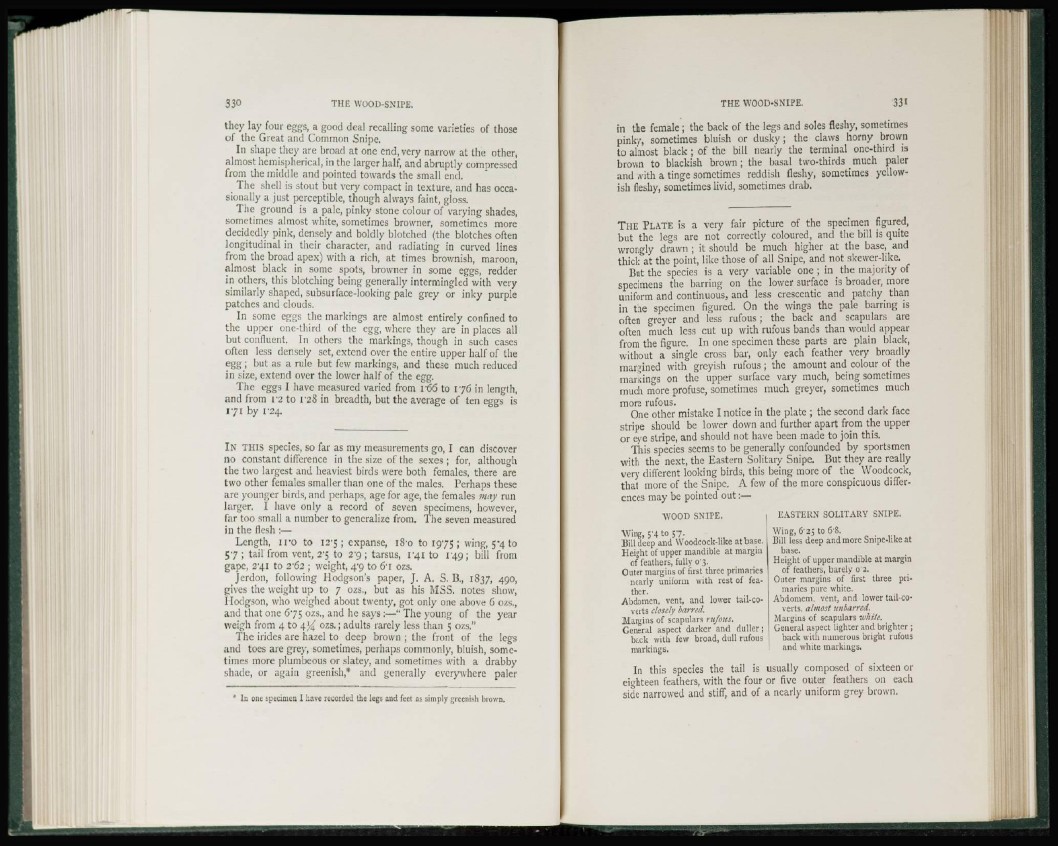
they lay four eggs, a good deal recalling some varieties of those
of the Great and Common Snipe.
In shape they are broad at one end, very narrow at the other,
almost hemispherical, in the larger half, and abruptly compressed
from the middle and pointed towards the small end.
The shell is stout but very compact in texture, and has occasionally
a just perceptible, though always faint, gloss.
The ground is a pale, pinky stone colour of varying shades,
sometimes almost white, sometimes browner, sometimes more
decidedly pink, densely and boldly blotched (the blotches often
longitudinal in their character, and radiating in curved lines
from the broad apex) with a rich, at times brownish, maroon,
almost black in some spots, browner in some eggs, redder
in others, this blotching being generally intermingled with very
similarly shaped, subsurface-looking pale grey or inky purple
patches and clouds.
In some eggs the markings arc almost entirely confined to
the upper one-third of the egg, where they are in places all
but confluent. In others the markings, though in such cases
often less densely set, extend over the entire upper half of the
egg ; but as a rule but few markings, and these much reduced
in size, extend over the lower half of the egg.
The eggs I have measured varied from I'66 to 176 in length,
and from 1*2 to 1*28 in breadth, but the average of ten eggs is
171 by 1 24.
IN THIS species, so far as my measurements go, I can discover
no constant difference in the size of the sexes; for, although
the two largest and heaviest birds were both females, there are
two other females smaller than one of the males. Perhaps these
are younger birds, and perhaps, age for age, the females may run
larger. I have only a record of seven specimens, however,
far too small a number to generalize from. The seven measured
in the flesh :—
Length, i r o to I2'5 ; expanse, l8-o to 1975; wing, 5*4 to
57 ; tail from vent, 2'5 to 2*9 ; tarsus, 1*41 to 1*49; bill from
gape, 2-4l to 2-62 ; weight, 4*9 to 6*1 ozs.
Jcrdon, following Hodgson's paper, J. A. S. B., 1837, 490,
gives the weight up to 7 ozs., but as his MSS. notes show,
Hodgson, who weighed about twenty, got only one above 6 ozs.,
and that one 675 ozs., and he says :—" The young of the year
weigh from 4 to 4 ^ ozs.; adults rarely less than 5 ozs."
The brides are hazel to deep brown ; the front of the legs
and toes are grey, sometimes, perhaps commonly, bluish, sometimes
more plumbeous or slatey, and sometimes with a drabby
shade, or again greenish,* and generally everywhere paler
* In one specimen I have recorded the legs and feet as simply greenish brown.
in the female ; the back of the legs and soles fleshy, sometimes
pinky, sometimes bluish or dusky; the claws horny brown
to almost black ; of the bill nearly the terminal one-third is
brown to blackish brown ; the basal two-thirds much paler
and with a tinge sometimes reddish fleshy, sometimes yellowish
fleshy, sometimes livid, sometimes drab.
THE PLATE is a very fair picture of the specimen figured,
but the legs are not correctly coloured, and the bill is quite
wrongly drawn ; it should be much higher at the base, and
thick at the point, like those of all Snipe, and not skewer-like.
But the species is a very variable one ; in the majority of
specimens the barring on the lower surface is broader, more
uniform and continuous, and less crescentic and patchy than
in the specimen figured. On the wings the pale barring is
often greyer and less rufous ; the back and scapulars are
often much less cut up with rufous bands than would appear
from the figure. In one specimen these parts arc plain black,
without a single cross bar, only each feather very broadly
margined with greyish rufous ; the amount and colour of the
markings on the upper surface vary much, being sometimes
much more profuse, sometimes much greyer, sometimes much
more rufous.
One other mistake I notice in the plate ; the second dark face
stripe should be lower down and further apart from the upper
or eye stripe, and should not have been made to join this.
This species seems to be generally confounded by sportsmen
with the next, the Eastern Solitary Snipe. But they are really
very different looking birds, this being more of the Woodcock,
that more of the Snipe. A few of the more conspicuous differences
may be pointed out:—
WOOD SNIPE.
Wing, 5'4 to 57.
Bill deep and Woodcock-like at base.
Height of upper mandible at margin
of feathers, fully 0*3.
Outer margins of first three primaries
nearly uniform with rest of feather.
Abdomen, vent, and lower tail-coverts
closely barred.
Margins of scapulars rrt/aus.
General aspect darker and duller ;
back with few broad, dull rufous
markings.
EASTERN SOLITARY SNIPE.
Wing, 6-25 to 68.
Bill less deep and more Snipe-like at
base.
Height of upper mandible at margin
of feathers, barely 02.
Outer margins of first three primaries
pure white.
Abdomens, vent, and lower tail-coverts,
almost unbarred.
Margins of scapulars white.
General aspect lighter and brighter ;
back with numerous bright rufous
and white markings.
In this species the tail is usually composed of sixteen or
eighteen feathers, with the four or five outer feathers on each
side narrowed and stiff, and of a nearly uniform grey brown.